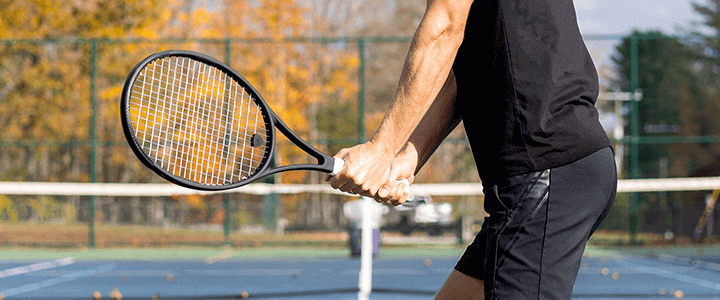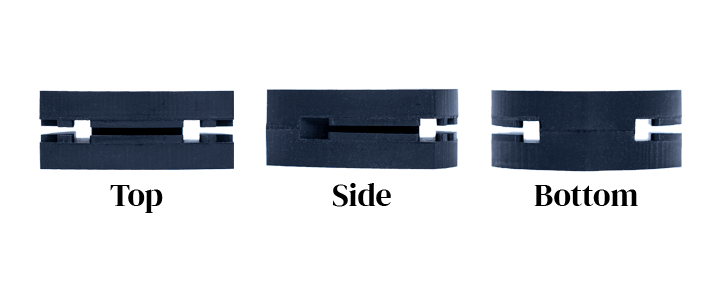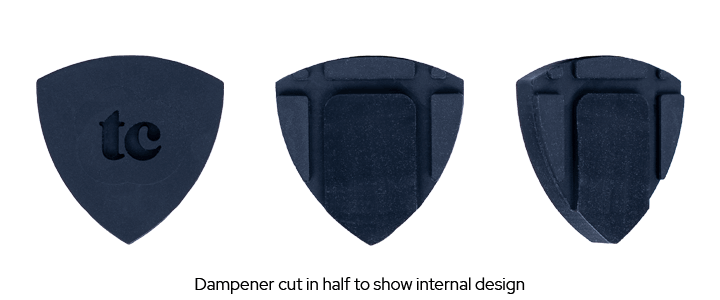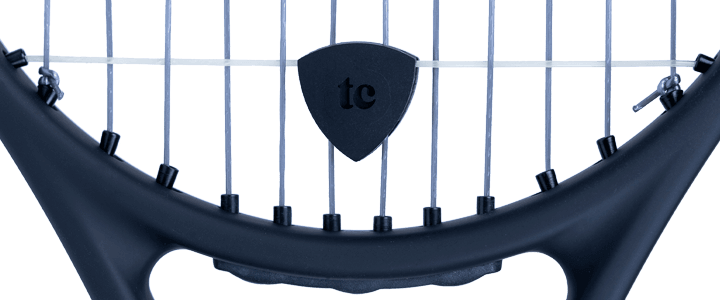Check out my custom vibration dampener
The 11 Best Tennis Racquet Vibration Dampeners
A detailed guide on vibration dampeners
We hope you love this article. Just so you know, TennisCompanion may collect a small share of sales from the links on this page to help keep this site running. Learn more.
If you’re just getting started with tennis, you may be asking, “Should I use a tennis dampener in my racquet?” The truth is, it’s not a simple yes or no answer – instead, it’s a subjective preference.
If you were to ask ten different tennis players whether or not they like them or not, you’d likely get ten different answers.
Regardless, many players can’t live without them, so I’ll dive deep into the topic in this article. I’ll cover everything from why they exist to installation and their impact on racquet performance.
Along with sharing details on my vibration dampener that I designed to fix many of the issues I’ve found with other dampeners, I handpicked the following selection of the best vibration dampeners from top brands. As part of this guide, I’ll review each dampener and why I selected it.
| Brand | Vibration Dampener |
| TennisCompanion | TennisCompanion Vibration Dampener |
| Tourna | Tourna Sampras |
| Wilson | Wilson Pro Feel |
| 21k Sports | 21k Sports |
| Head | Head Djokovic |
| Outus | Outus Dampeners |
| Muzitao | Muzitao Emoji Dampeners |
| Babolat | Babolat Custom Damp |
| Head | Head Smartsorb |
| Just Tennis | Vibra Worm |
| Gamma | Gamma Shockbuster II |
| Bonus: DIY | #64 Rubber Bands |
Article Contents
Click below to jump to a section
Tap below to jump to a section
Dampener Index
What Is a Dampener?
What’s the Purpose?
Shock & Tennis Elbow
Racquet Performance Impact
Types of Dampeners
Dampener Placement
How to Install
Should You Use Them?
TennisCompanion Dampener
Tennis Dampener Guide
Bonus: DIY Dampener
New to TennisCompanion?
Create a free account and explore my latest videos below
Tennis Dampener Index
Here are my favorite picks for the best vibration dampeners on the market. Click the following links to jump to that section and learn more.
You can also learn more about the vibration dampener I developed by clicking here.
- Tourna Sampras
- Wilson Pro Feel
- 21k Sports
- Head Djokovic
- Outus Dampeners
- Muzitao Emoji Dampeners
- Babolat Custom Damp
- Head Smartsorb
- Vibra Worm
- Gamma Shockbuster II
- Bonus: DIY #64 Rubber Bands
Next up, let’s dive into the details.
What is a Tennis Racquet Vibration Dampener?
Let’s rewind for a moment. In 1964, Rene Lacoste developed the first vibration dampener called the Tanti-Vibration Dampener to help with the vibration that occurs when a player strikes the ball.
Initially, the intention was for the dampener to reduce the risk of injury, but it didn’t quite pan out that way. Today, Lacoste no longer makes this dampener, but many other brands followed suit and created dampeners, which have become a staple tennis accessory.
For clarity, vibration dampeners are small devices, typically made of rubber or similar synthetic material that insert into a racquet’s stringbed outside the pattern of crossed strings and below the lowest cross string of a racquet, directly above the throat of a tennis racquet.
What’s the Purpose of a Vibration Dampener?
If you review the marketing for the vast majority of vibration dampeners, you’ll see claims of reducing vibration to improve comfort and reduce or prevent injury. However, research has shown they do little more than mute the audible “ping” you hear when striking a ball, particularly with a freshly strung racquet.
In 2004 Dr. François-Xavier Li released a study in the Journal of Sport Sciences with the following remarks.
“String vibration dampers do not reduce racket frame vibration transfer to the forearm.”
The study’s ultimate conclusion on why they remain popular:
“We suggest that string dampers remain a popular accessory among tennis players because of their acoustic effects and psychological support rather than any mechanical advantage.”
Despite this research, the myth of vibration dampeners reducing vibration and shock a player feels in their arm when hitting a tennis ball persists mainly due to how manufacturers market them.
Speaking from personal experience, I agree with their primary finding that despite not increasing comfort, they do a great job at muting the “ping” sound you hear when striking the ball.
Shock & Tennis Elbow
Some players suffer from tennis elbow, due to the repetitive motion associated with swinging a racquet combined with the shock your forearm sustains each time you hit a ball and the subsequent vibrations that travel to your arm as well.
The pain can be anywhere from slightly uncomfortable to excruciatingly painful. As you’d expect, players are always on the lookout for products that can help reduce the pain and keep them on the court, and vibration dampeners are one of those accessories.
Unfortunately, as shown in the previous section, vibration dampeners do not have a material impact on reducing the vibration or shock a player feels in their arm when swinging to hit a tennis ball.
Recognizing this, placing a vibration dampener on your racquet would serve more as a mental Band-Aid to a deeper issue that may involve your tennis equipment or technique.
If you’re suffering from tennis elbow, I’d first recommend you spend some time with your doctor. However, I’d also recommend you review your technique with a qualified tennis professional and consider the type of tennis racquet and the type of tennis string you’re using.
A racquet that’s too heavy, a frame that’s too stiff, or a string that’s too rigid and harsh like polyester or Kevlar can significantly impact the shock and vibration a player endures.
Racquet Performance Impact
Now that you know why you might consider using a vibration dampener let’s talk about its effect on racquet performance.
Frequently, players consider the following attributes when evaluating the performance of a tennis racquet because the specs (length, weight, balance, head size, stiffness, etc.) contribute to them.
- Power
- Control
- Maneuverability
- Stability
- Comfort
- Feel
- Spin
Ultimately, vibration dampeners aren’t significant enough to have a material impact on most of these attributes.
However, there is one exception I’d argue, and that’s feel. While research proved dampeners don’t reduce frame vibration to the forearm, I believe they have a noticeable impact on the feel of a racquet.
Of course, feel is highly subjective, but psychological or not, it matters in tennis, so I think it’s worth mentioning and one of the main reasons I use them in my tennis racquets.
With that said, I think it’s safe to say vibration dampeners do impact racquet performance, but it’s subtle and will be perceived differently from player to player.
Types of Vibration Dampeners
There are two primary types of tennis racquet vibration dampeners.
- Button
- Worm
Button dampeners are the most common type of vibration dampener and are referred to as such because they’re circular and roughly the size of a large button or coin and usually only overlap two main strings.
Popular button dampeners include the custom Novak Djokovic vibration dampener from Head and the classic Pete Sampras dampener from Tourna. These days, button-style dampeners come in various shapes, but the size and string coverage remain roughly similar.
The other common type of vibration dampener is a “worm” dampener. Aptly named, these dampeners are long and thin, roughly in the shape of a worm. Popular worm dampeners include the Gamma Shockbuster and the Head Smartsorb.
The main difference between the two is that worm dampeners come in contact with more strings and therefore have a more substantial impact on reducing the sound of your strings when hitting.
Dampener Placement
Vibration dampeners are placed or woven between a tennis racquet’s main or vertical strings outside the cross or horizontal strings.
There are two key reasons for this placement. First, when you’re hitting, you don’t want the tennis ball to accidentally come in contact with the vibration dampener and lead to a mishit.
However, the second and lesser-known reason for this particular placement is that it’s in the rules.
In section 4 of the ITF Rules of Tennis, the use of vibration dampeners is addressed head-on as a part of five common cases they encounter:
Case 3: Can vibration damping devices be placed on the strings of a racket? If so, where can they be placed?
Decision: Yes, but these devices may only be placed outside the pattern of the crossed strings.
That means you can place dampeners on the bottom, top, left, or right of the stringbed. Of course, back to reason one, players typically place them at the bottom of the stringbed above the racquet’s throat to prevent them from interfering when hitting.
It’s worth noting that the rules don’t explicitly prevent players from using multiple vibration dampeners as long as they don’t violate the above rule. Still, it’s entirely unnecessary to do so.
How to Install a Dampener
Overall, installing vibration dampeners is pretty painless.
Button vibration dampeners are the easiest to install, as they simply need to be inserted in between the two center main or vertical strings.
First, push the slotted edge of the dampener against one of the main strings until it’s sung. Then holding the opposite side of the dampener, pull the dampener and second main string away from each other until you can align it with that string. Once it’s between the main strings, push it up against the lowest cross or horizontal string, and that’s it.
Worm dampeners come in a few different shapes and sizes, but generally, they weave between the main strings, which helps reduce vibration across more of the strings that frequently come in contact with the ball. Some tend to be a pain to install, and many designs require you to follow the instructions on the package, but once inserted, they’re not going anywhere until they break or you need to restring.
Two things that can make dampeners more challenging to install are the size of the dampener and how dense the string pattern of your racquet happens to be. Anything above a 16×18 string pattern, i.e., 16×19, 18×20, etc., can start to get tricky, or the dampener may end up looking scrunched. Consider this factor before making your purchase.
When in doubt, refer to the dampeners included instructions.
Should You Use a Vibration Dampener?
Unfortunately, this is a question only you can answer.
Luckily, they’re inexpensive. Our recommendation is to purchase a package and see how you like the sound and feel, or if a friend uses one, ask them to borrow it for a few minutes the next time you’re on the court.
Many players have a relatively strong reaction to them and either love or hate them. For most people, it only takes a few minutes to come to that conclusion.
When I was younger, I disliked the “ping” sound and didn’t feel like I was hitting solid without a dampener in my racquet. Then, when I moved to a new type of string in high school, I tried hitting again without a vibration dampener preferred the feel. However, I used one throughout college after changing racquets, and I still use one today.
Of course, remember that the only benefits you will gain by using one are reducing the “ping” noise when hitting and a subtle change in feel. It’s not going to help with comfort or prevent injury.
TennisCompanion Vibration Dampener

I’ve used vibration dampeners on and off throughout my career as a tennis player. However, having tried various brands and styles over the years, I was never fully satisfied with any of them.
Here are some of the main issues I encountered:
- Challenging to install: Especially some of the longer worm-style dampeners. Not impossible, just unnecessarily difficult. On top of it, once installed, they often didn’t fit right.
- Unsecure fit: Once I hit high school, I gravitated toward button-style dampeners, but they often went flying unexpectedly out of my racquet during a point, which was not only distracting but half the time I couldn’t find where it went. The string pattern of a racquet can drastically influence how secure a dampener fits.
- Lackluster performance: Every dampener influences the sound of your racquet and feel a bit differently. The material, density, and shape all play a role, and some simply don’t work as well as others.
- Sub-par materials: Some dampeners either crack or break due to the quality of material and design, which is frustrating.
- Unnecessary bulk and weight: The larger the dampener, the heavier it is, which influences a racquet’s balance and swingweight. Overall, we’re talking subtle differences, but I prefer less added weight.
- Loud branding: If you like a particular tennis brand, then you may happily use their dampener, but some of the logos can be a bit in your face. I always enjoyed dampeners that were subtle and matched my racquet independent of my racquet’s color or brand.
With those in mind, I set out to create a dampener that would address these issues and that I’d be happy to use in my racquet.
Material

I first started by testing various materials to gauge their performance and feel and eventually landed on silicone as an ideal substance, primarily for its highly resilient and durable properties.
Density

Next up, I experimented with the hardness or density of silicone, which I found to impact a dampener’s performance significantly. Eventually, I settled on a softer compound that provided an optimal feel while delivering an appealing sound on impact.
Construction

Once I had the material selected, I evaluated a variety of shapes and sizes that would provide ideal coverage of my strings and ensure a secure fit without unnecessary bulk and weight.
During my research, I stumbled on a unique geometric shape called a reuleaux triangle, which works incredibly well, providing an optimal balance between the right amount of material for dampening and weight.
I also developed internal teeth for the dampener that form distinct grooves for the strings and ensure a secure locked-in fit while remaining easy to install.
Design

Last but not least, I didn’t want the dampener to stand out unnecessarily, so I opted for a subtle matte black design with a debossed TennisCompanion logo that’s intended to look great on all frames.
Regardless of the racquet model, head size, string pattern, or string gauge you’re using, the TennisCompanion vibration dampener delivers exceptional performance that I think you’ll love.
Best Vibration Dampeners Guide
These days, there are thousands of different styles and colors of vibration dampeners available, but some are better than others.
Keep reading to check out reviews of the best available.
Tourna Sampras
The Tourna Sampras is a classic vibration dampener that’s simple yet effective. While we love what others have done with their dampeners, at times, they feel overcomplicated.
Each dampener is in the shape of a circle that’s hallow like a donut and features “Pete Sampras” printed along the sides. Your pack will come with two of them, which comes in handy because you’ll invariably misplace them from time to time.
Wilson Pro Feel
Another classic vibration dampener on our list comes from none other than Wilson, one of the world’s most well-known and respected sporting brands. The Pro Feel uses the iconic “W” shape and stays locked in place as long as you push it snug with the bottom-most cross string.
Like the Tourna Sampras, it’s simple, uncomplicated, and drop-dead-easy to install. It also comes in a few different colors, including blue, yellow, red, and silver. Each pack comes with two.
21k Sports
If you’re on the hunt for maximum dampening, then you should check out this three-pack from 21k Sports. Each dampener will cover six strings giving you that ultra muted feel.
The team over at 21k Sports also offers up their vibration dampeners in nine different colors, including a multi-colored option. Whether you have multiple racquets to equip or you always want a few backups on hand, they have you covered.
Helpful Tip
If your tennis racquet features a string pattern that’s denser than 16×18, you may want to consider an alternative or go into the purchase knowing that they might not fit. It’s, unfortunately, one of the main downsides we’ve experienced with this particular model.
Head Djokovic
Novak Djokovic’s signature vibration dampener model is a popular choice that’s simple yet effective.
It’s a circle in shape and comes in white with the Head logo on one side and the stylish Djokovic “D” on the opposite. Each pack comes with two dampeners and is a great all-around option.
Outus Dampeners
If the other vibration dampeners on our list are a bit bland for your taste, then these expressive dampeners might be right up your alley.
Each pack comes with 21 fun and unique dampers. Our personal favorites are the panda and pig, but you’ll have plenty to choose from in the package. Regardless of which you select, these are sure not to disappoint and make a great idea for a tennis gift – especially for kids.
Muzitao Emoji Dampeners
Sometimes all you need to express yourself is an emoji, and the makers at Muzitao get it. They sell two separate packs of these with slightly different styles and emotions, and they’ll fit most tennis racquets without any issues.
These are particularly popular with parents and young children and also make great gifts and stocking stuffers.
Babolat Custom Damp
If you’re a huge Rafa fan, then look no further than the Babolat Custom vibration dampener, which he uses in his racquet. Each pack comes with two dampeners, and they’re available in black, white, and yellow.
What makes them custom? You can use them hollow without anything in the center, similar to the Tourna Sampras, or insert a small capsule containing three steel beads that fit securely within the center to adjust the level of dampening.
Head Smartsorb
A worm-style dampener from Head, the Smartsorb, will weave through 6 strings on your racquet for maximum coverage, with small clasps at either end to help keep it secure.
It comes in various colors, including grey, silver, black, yellow, red, and blue. This style dampener is one that many players enjoy when they find some of the smaller dampeners fly out of their strings from time to time.
Vibra Worm
The Vibra Worm is another popular vibration dampener that will cover up to six strings on your racquet with clasps at either end to prevent it from coming loose during play.
Each pack comes with six, including three black and one in blue, red, and yellow. Like many worm-style dampeners, be careful not to pull too hard on these because their clasps are known to break under pressure.
If you’re looking at the Gamma Shockbuster, which has a near-identical design, then these are worth checking out for the price.
Gamma Shockbuster II
For those of you that can’t get enough dampening goodness in your racquet, there’s the Gamma Shockbuster II, which is the big brother to the original Shockbuster. The first generation featured a single gel strip to reduce shock, but apparently, that wasn’t enough for some players.
Enter the Shockbster II with two strips instead of one. Like the original, it features clasps on either side to keep it secure. Be careful not to overstretch it to prevent having one of the clasps break.
Bonus: DIY #64 Rubber Band Dampener
If you were an Andre Agassi fan, you’re likely familiar with the rubber band dampener he made famous. The best part about this do-it-yourself vibration dampener? They work surprisingly well.
If you’re frustrated with your current vibration dampener or perhaps can’t get over paying the price of a specialty model, then you should give rubber bands a try.
Any rubber band will do, but different sizes will have varying degrees of impact on the noise and feel of your racquet. If you’re looking to emulate Agassi, then you’ll be looking for size 64 rubber bands.
For the price of most of the dampeners on our list, you can get a few hundred these DIY dampeners that you can stash in your bag and have for years. What’s not to love about that?
Wrapping Up
Love them or hate them, vibration dampeners are here to stay and will likely remain one of the most popular tennis accessories for decades to come.
If you haven’t had a chance to use a vibration dampener before, then give them a try. Whether you dig up a spare rubber band in that random kitchen drawer or pick from our list, you may find you enjoy the reduction in noise and change in feel.
Have any lingering questions? Let us know in the comments below or share which vibration dampener is your favorite.
Home > Gear > Accessories > Vibration Dampeners
Play Better Tennis
Improve your game alongside our community of tennis players
Why join?
Discussion Boards
Join the conversation with other members of the community.
5 Point Friday
Read our weekly recap of the 5 most interesting things we dig up in tennis.
Trackbacks & Pingbacks
Leave a Reply
Want to join the discussion?Feel free to contribute!



Good article! Thank you! :)